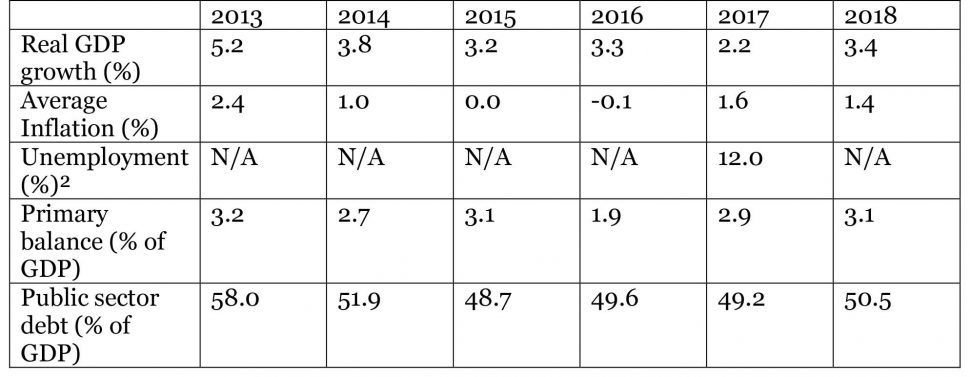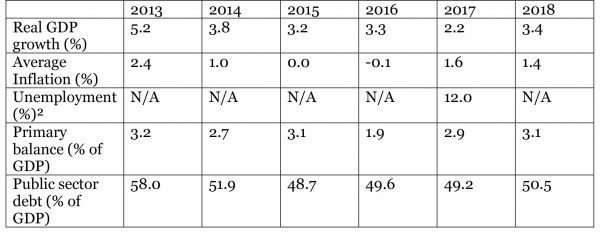Guyana is on the verge of a sharp increase in economic growth but “immediate prospects partly depend on ending political uncertainty,” the Caribbean Development Bank’s (CDB) Economic Review for last year says.
According to the six-page document, which was released by the CDB, the budget speech that was presented by Minister of Finance Winston Jordan last year November identified a target growth rate of 4.6%, with all major sectors contributing.
“However, increased political uncertainty in early 2019 may dampen this momentum. The National Industrial and Commercial Investments Limited (NICIL) bond issue will push total public and publicly guaranteed debt above 60% of GDP in 2019 but that ratio is projected to decline sharply after 2020,” the review said, while noting that business reforms are needed to improve competitiveness and facilitate inclusive growth.
It also noted that while efforts are being made to increase linkages between the oil industry and the rest of the domestic economy, there is a risk that oil production could dominate exports and lead to exchange rate appreciation that could harm the competitiveness of other sectors.
To counter this, it said, the National Resources Fund (NRF) can help to manage some of those risks but business-sector reforms will also be necessary as improvements are needed in reducing energy costs, the speed of getting construction permits and trading across borders.
In its overview, the review explained that the increase of 3.4% in economic growth in the country was mainly due to an increase in construction activity, which also rose by 12%.
“Sugar output fell as restructuring of the industry continued, while there was mixed performance in the extractive industries. Fiscal performance was boosted by a tax amnesty, which increased revenues and helped stabilise the overall deficit,” the review said, while noting that public debt as a percentage of GDP increased.
It further stated that as preparation for oil production continues, commercial production that is due to start in 2020 will increase economic growth and provide windfall revenues for the Government of Guyana and the proposed NRF is supposed to help manage the risk associated with the new development, including minimising negative impacts on other non-oil industries.
However, it said that reforms to the doing-business environment are also necessary to ensure that the non-oil industries can become more competitive, while other risks include political uncertainty.
As it relates to key developments last year, the review said that based on the Ministry of Finance’s data of 3.4% growth, it partly reflected preparation for the first oil in 2020.
“Output from other services was up 15%, linked to increased visitor arrivals. Of the traditional main industries, sugar output fell by nearly 30%. Restructuring of the Guyana Sugar Company (GuySuCo) was financed by a five-year external bond issue for $30 billion (3.7% of GDP). This restructuring includes reducing the work force and divesting assets, in order to reduce subsidies. The mining industries had mixed fortunes. Gold extraction declined, mainly due to falling declarations by small and medium-scale miners,” it said, while noting that bauxite production was up along with the declaration of diamonds, sand and stone.
Inflationary
The review added that inflation averaged 1.4% last year, compared to 1.6% in 2017 and the decreased reflected lower price increases for food and for housing but inflationary pressures are expected to increase in the next two years as the country readies itself for oil production.
As it relates to unemployment, the document noted that data published by the Guyana Bureau of Statistics (GBS) in 2017 in its Labour Force Survey (LFS) showed that overall unemployment was 12% and that it was higher for women at 15.3% while only 9.9% for men. However, for young people between the ages of 15 to 24, the female unemployment figure recorded was 28% while the male unemployment rate was 17.3%. The CDB also noted that the LFS also reported gender disparities in earnings, which was partly due to men working longer hours than women.
In terms of revenue collection, the CDB noted that the tax amnesty boosted revenue collection and allowed the fiscal deficit to stabilise. It explained that the move resulted in extra collections worth about one per cent of the GDP and that total revenue collected last year was 11% more than 2017. Total expenditure was 8.7% higher last year and this, the document said, was due to an increase in transfers.
The CDB also noted that the debt stock rose as well as servicing costs, but with the economy growing, the ratio of debt to GDP fell to 44.5% last year. Additionally, the government overdraft was about 6% of the GDP and external debt service increased because of higher principal payments to bilateral and multilateral lenders, rising interest rates and exchange rate depreciation. It also noted that the fall in domestic debt reflected a lower stock of treasury bills.
Net credit from the banking system also increased, while further measures were taken to strengthen the financial sector. The CDB noted that net domestic credit grew by 13.6% in the first 10 months last year, reflecting higher loans to both Central Government and the private sector. Commercial loans were also up for agriculture, manufacturing and construction but went down for mining.
“The ratio of gross non-performing loans to total loans was 12.8% at the end of June, 22 basis points less than in June 2017. Bank capitalisation continued to be satisfactory, with the Capital Adequacy Ratio improving from 29.2% to 30.6% in the year to June,” the CDB said, while noting that the pressure on Correspondent Banking Relationships continued to ease, although charges for some cross-border transactions increased and some of the banks received limited services.
The CDB also said that gross international reserves fell to just above three months of imports and the overall deficit tripled to 4.9% of the GDP. “The current account deficit worsened as export earnings fell and imports rose, specifically fuel. The services deficit also deteriorated. The financial account surplus strengthened, thanks to higher foreign direct investment and loan disbursements,” the CDB added, while noting that the balance of payments deficit was funded by debt relief and debt forgiveness worth US$76.6 million, as well as the drawdown on international reserves.
The table summarises the key economic and social indicators underpinning the Country Brief. The data have been taken from a number of sources and are the latest available at the time of publication, the CDB said, while noting that some are subject to revision. The 2018 data are CDB estimates.






